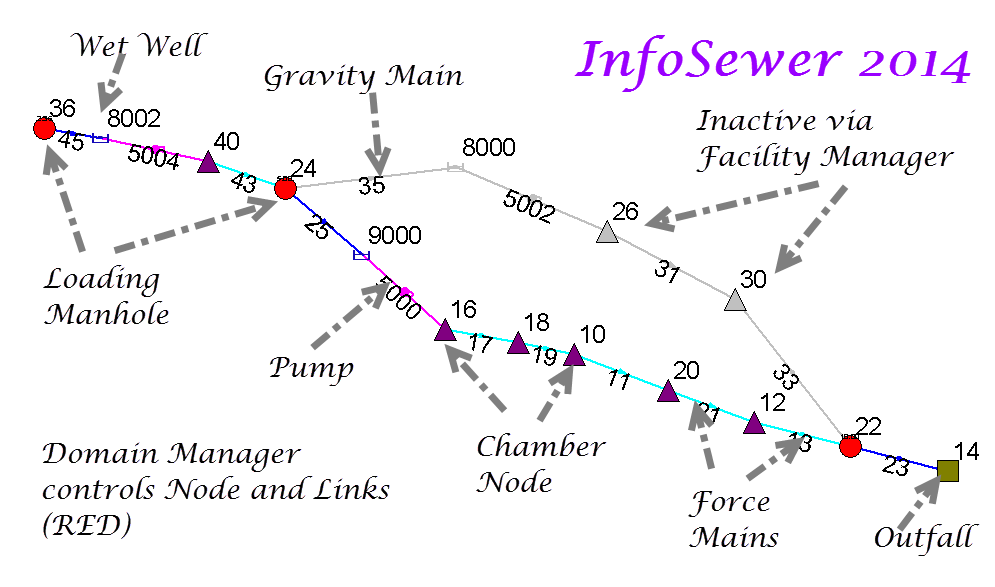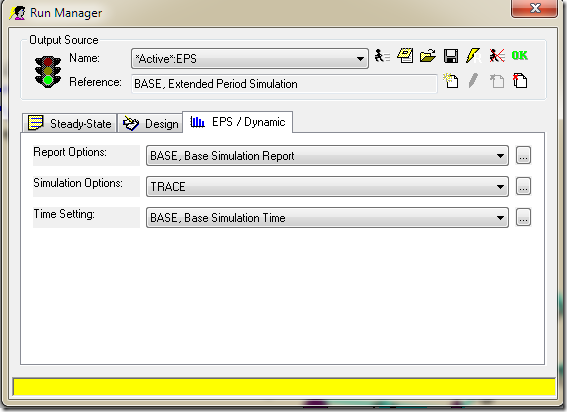🚧 The Advanced Force Network Support in a sewer system offers a sophisticated 🖥️ simulation model for multiple upstream and downstream force mains that enter and depart a singular junction chamber. This simulation is designed for Extended Period Dynamic Simulation (EPS) 🔄, considering all connected force mains, pumps, wet wells, and force main chamber junctions as one integrated force main network. This powerful feature 🌟 allows for comprehensive network analyses, particularly useful in large Sewer models that may contain more than one force main network, separated by gravity pipes and loading manholes. The various force main networks are solved iteratively, taking into account differing upstream heads and downstream tail manholes, which connect these networks to the rest of the sewer system. 🌊
🔍 Let's delve into the key elements constituting a force main network:
Wet Well: 🚿 This is essentially a holding tank where incoming wastewater is temporarily stored before it's pumped to a higher level or where it's temporarily retained until it can flow out to the sewer system by gravity.
Pump: 💦 The pump propels the wastewater from the wet well to a higher elevation. Depending on the requirements of the specific system, these pumps can vary in type and capacity. Their operation can be automatic, based on the level of wastewater in the wet well, or manually controlled.
Junction Chamber: 🛠️ This is a critical component where multiple force mains converge or diverge. In the junction chamber, flows from different lines are combined or separated, depending on whether they are incoming or outgoing.
Head Manhole or Loading Manhole: 🕳️ The head manhole, also known as a loading manhole, is where the flow from other parts of the sewer system enters the force main network. It essentially serves as the entry point for wastewater into the force main system. These structures can also be designed to handle excess flow during peak times.
Tail Manhole: 🚪 The tail manhole is where the flow leaves the force main network. It serves as an exit point for the wastewater, leading it out of the force main system and into other parts of the sewer network, often those operating by gravity flow.
🖥️ Elements in InfoSewer
The identification of the head and tail manhole for a force main network is astutely determined by the software itself, guided by the precise geometry of the network. A force main network springs from a wet well, incorporating pumps that establish a connection from the wet well to the force main links. The actual force main links and the force main connecting junction chambers are also integral parts of this system. Notably, the software offers the flexibility to link a force main directly to the gravity mains, bypassing the need for an intermediate wet well and pumps.
Two critical boundary conditions 📏 help define the dynamics within the force main network:
Water Heads at Wet Wells: 🌊 These vary as a function of the inflow from the upstream portions of the sewer network and outflow to the force main network. Essentially, as inflow rates from upstream sections change, the water head or the hydraulic grade line in the wet well adjusts accordingly.
Water Head at Tail Manholes: 📊 These are calculated as the maximum discharge head, a sum of the manhole invert elevation and the diameter of the force mains that terminate at that manhole.
Through these boundary conditions, the software effectively manages and simulates the behavior of the wastewater within the network, ensuring optimum functionality. As water levels fluctuate in response to inflow and outflow dynamics, the software's ability to adjust and manage these shifts helps maintain the operational integrity of the sewer system.
📚 An Example of how Newton Raphson Solves for Zero
For example, assuming there are n1 wet wells, n2 head manholes, n3 tail manholes, n4 junction chambers and l1 pumps and l2 force mains, the program must solve the network hydraulics to get n2+n4 water head values and l1+l2 flow values iteratively using the Newton-Raphson method. The solution iterates until the mass and energy of the force main network is in balance. The hydraulic equations used in the solution are essential for understanding the intricacies of the system.
Advanced Force Network Support in InfoSewer for Steady State and EPS
- Simulation Options for the Advanced ForceMain Network Support
The Advanced Force Network Support in a sewer system offers a sophisticated simulation model for multiple upstream and downstream force mains that enter and depart a singular junction chamber. This simulation is designed for Extended Period Dynamic Simulation (EPS), considering all connected force mains, pumps, wet wells, and force main chamber junctions as one integrated force main network. This powerful feature allows for comprehensive network analyses, particularly useful in large Sewer models that may contain more than one force main network, separated by gravity pipes and loading manholes. The various force main networks are solved iteratively, taking into account differing upstream heads and downstream tail manholes, which connect these networks to the rest of the sewer system.
Let's delve into the key elements constituting a force main network:
Wet Well: This is essentially a holding tank where incoming wastewater is temporarily stored before it's pumped to a higher level or where it's temporarily retained until it can flow out to the sewer system by gravity.
Pump: The pump propels the wastewater from the wet well to a higher elevation. Depending on the requirements of the specific system, these pumps can vary in type and capacity. Their operation can be automatic, based on the level of wastewater in the wet well, or manually controlled.
Junction Chamber: This is a critical component where multiple force mains converge or diverge. In the junction chamber, flows from different lines are combined or separated, depending on whether they are incoming or outgoing.
Head Manhole or Loading Manhole: The head manhole, also known as a loading manhole, is where the flow from other parts of the sewer system enters the force main network. It essentially serves as the entry point for wastewater into the force main system. These structures can also be designed to handle excess flow during peak times.
Tail Manhole: The tail manhole is where the flow leaves the force main network. It serves as an exit point for the wastewater, leading it out of the force main system and into other parts of the sewer network, often those operating by gravity flow.

- Elements in InfoSewer
The identification of the head and tail manhole for a force main network is astutely determined by the software itself, guided by the precise geometry of the network. A force main network springs from a wet well, incorporating pumps that establish a connection from the wet well to the force main links. The actual force main links and the force main connecting junction chambers are also integral parts of this system. Notably, the software offers the flexibility to link a force main directly to the gravity mains, bypassing the need for an intermediate wet well and pumps.
Two critical boundary conditions help define the dynamics within the force main network:
Water Heads at Wet Wells: These vary as a function of the inflow from the upstream portions of the sewer network and outflow to the force main network. Essentially, as inflow rates from upstream sections change, the water head or the hydraulic grade line in the wet well adjusts accordingly. Likewise, changes in the outflow rate to the force main network also influence these water head levels. The interplay of these dynamics is crucial in maintaining the balance of the entire system and ensuring efficient wastewater transportation.
Water Head at Tail Manholes: These are calculated as the maximum discharge head, a sum of the manhole invert elevation and the diameter of the force mains that terminate at that manhole. The water entering the tail manholes, once the force main network flows have been calculated, is then routed downstream. In essence, the tail manhole functions as a critical junction that navigates the water from the high-pressure force main system to the downstream gravity flow sections.
Through these boundary conditions, the software effectively manages and simulates the behavior of the wastewater within the network, ensuring optimum functionality. As water levels fluctuate in response to inflow and outflow dynamics, the software's ability to adjust and manage these shifts helps maintain the operational integrity of the sewer system.

- An Example of how Newton Raphson Solves for Zero

 the pump curve is used to estimate the flow and head gain relationship within a pump. For Inflow Control and Discharge Control pump, pump flow as control values are fixed and the equation Q = Qcontrol, where Qcontrol is the controlling pump value. For such situations, the pump is actually modeled as a variable speed pump and pump speed will be calculated with the Newton-Raphson method to achieve the flow control objective.
the pump curve is used to estimate the flow and head gain relationship within a pump. For Inflow Control and Discharge Control pump, pump flow as control values are fixed and the equation Q = Qcontrol, where Qcontrol is the controlling pump value. For such situations, the pump is actually modeled as a variable speed pump and pump speed will be calculated with the Newton-Raphson method to achieve the flow control objective.

![SNAGHTML16139c80[19] SNAGHTML16139c80[19]](http://swmm5.files.wordpress.com/2015/08/snaghtml16139c8019_thumb.png)

![SNAGHTML16495507[16] SNAGHTML16495507[16]](http://swmm5.files.wordpress.com/2015/08/snaghtml1649550716_thumb.png)


No comments:
Post a Comment